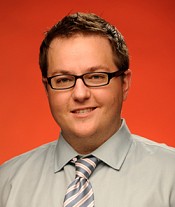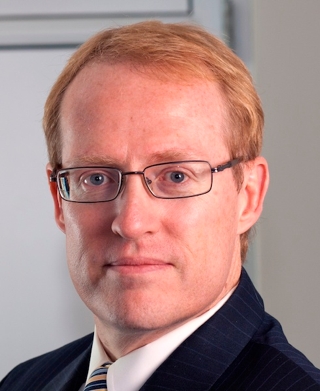Home » Mobile Cloud Computing » One-on-one with the faculty behind Tackling Big Questions with Mobile Cloud Computing (Part 2 of 3)
One-on-one with the faculty behind Tackling Big Questions with Mobile Cloud Computing (Part 2 of 3)
Posted by anderc8 on Wednesday, January 25, 2017 in Mobile Cloud Computing, News.
Vanderbilt University Computer Science professors Douglas C. Schmidt and Jules White recently sat down to answer a few questions about their University Course, Tackling Big Questions with Mobile Cloud Computing, which they co-taught during the Fall 2016 semester and are co-teaching again this spring. In the second installment of a three-part series, Profs. Schmidt and White discuss their goals for the Spring 2017 semester, address ways to better prepare non-CS students to take their course in future years and delve into the natural synergies that have formed between their University Course, their Trans-Institutional Program (TIPs), the Vanderbilt Institute for Digital Learning (VIDL) and the Wond’ry.
To read the first installment of this three-part blog, click HERE.

Vanderbilt Assistant Professor Jules White
What are your goals for the Spring 2017 semester?
Jules: We’re hoping that more of these projects will develop mature apps that are worthy of productizing and transition via the Wond’ry. Encouraging this sort synergy is precisely why we co-located this class in new Engineering and Science Building, where the Wond’ry is housed. The Malnutrition app is one project that’s already started down this path, but we suspect there will be others, as well, such as the team that’s working on an app for a geo-located “liquid workforce” in the oil and gas industry.
Doug: We’re planning to continue and expand upon about half the projects that were most successful last semester. Now that we’ve got an entire semester to build the apps, the teams should be able to create much more complete and robust solutions that meet the requirements of their faculty/staff mentors. We’ve also defined some new topics that students can work on based on our most recent multi-disciplinary research collaborations with colleagues in other schools at Vandy and VUMC. For example, together with researchers from the Bio-Medical Informatics group in VUMC we’ve been investigating the use of cutting-edge “block-chain” technologies, which are distributed ledgers that were originally designed to support secure virtual currency and e-commerce, but are now being considered for tracking electronic patient medical records, auditing transactions between producers and consumers of energy in smart grids, and so on. We’re finding ways to apply these novel block-chain technologies to many of the projects in our University Course.
How many students from your Fall 2016 semester course re-enrolled in the Spring 2017 offering?
Jules: On the CS side, around 75-80 percent of the students who took the class in the fall are taking it again this spring. Of the university students, probably 30-40 percent of that class has continued on as well. We also have a wait list of another dozen or so university students who would like to enroll in the spring semester, but the course is full to capacity. Hopefully, the university students who were not able to get into our class this spring will still be around in the fall when we start the whole process over again with new mentors and new projects so they can get involved.
How do you envision helping university students become better equipped to work with CS students in your University Course moving forward?
Doug: We’re working with John Sloop, the Vanderbilt Institute for Digital Learning, and others in the CS program and across campus to create a university-wide digital literacy program, so that everyone at Vandy knows something about computing and computational thinking by the time they graduate. Our goal is to create a series of these types of courses for the whole university. With these courses available as prerequisites, university students who take our University Course will be much better prepared since they will have gotten more programming experience, even if they aren’t CS majors. As a result, they’ll be more effective liaisons with the faculty/staff mentors from other Schools at Vandy because they’ll have a deeper technical understanding of what the CS students are doing. Likewise, we can tackle even more challenge problems in our University Course because the university students will be able to get more deeply involved with their team and work more effectively with CS students on topics that really matter to the broader community that Vandy serves.

Vanderbilt Professor Doug Schmidt
What synergies, if any, are there between the University Course, your TIPs project, and the Wond’ry?
Doug: We give a lot the credit here to Vanderbilt leadership for providing an ecosystem that enabled the confluence of several transformational things during the past couple of years. For example, they recognized that need for more entrepreneurial focus on campus via the Wond’ry since many Vanderbilt students have an interest in that topic. Both Jules and I had been involved with the Wond’ry for several years—even before its launch—helping to shape what it’s become. The TIPs initiative that’s fostering multi-disciplinary research on campus was again spearheaded by Vandy leadership. Jules and I are both involved with a TIPs project together with various faculty/staff from VUMC. However, each of these initiatives in isolation only go so far. In particular, TIPs provides a relatively small amount of money, so it’s hard to build a large team of faculty and students to tackle big problems since there’s not enough funding to support a group of students to do significant software development. Likewise, the Wond’ry doesn’t yet have the resources to mentor large groups students on deep technical subjects.
Fortunately, the University Course initiative provided us with an opportunity to guide a much larger team of students who can collaborate with faculty/staff on a wider range of multi-disciplinary projects during one or more semesters. As a result, the students get course credit for creating novel apps over an extended period of time. Likewise, we and our TIPs collaborators can write proposals based on the results of studies that apply these apps in the appropriate clinical settings. Moreover, by holding our course nearby the Wond’ry, we’re helping to foster a more sustainable ecosystem of people who can take these apps further and productize them.
We had this opportunity because Vanderbilt leadership decided to invest in each of those things separately and we’re just helping to bring them together. I don’t know if the Vanderbilt leadership intentionally rolled out these initiatives to facilitate this type of synergy, but we recognized the intersection immediately and knew that the confluence of these three things would ignite a great deal of interest on campus. In particular, faculty, staff, and students from all around campus want to tackle big problems, so our University Course provides a convenient vehicle to bring everyone together in a manner that aligns seamlessly with Vanderbilt’s strategic investments in multi-disciplinary research, teaching, and entrepreneurship.
